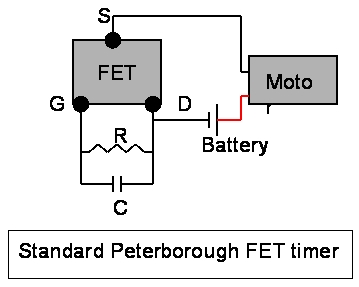 |
 |
|
Home Technical
|
A modified FET timer that dispenses with the need for a 9v PP3 battery to start the motor Bob Read appeared at Ferry one sunny afternoon with a FET timer which he had modified to dispense with the need for a separate 9v PP3 battery to get the motor going. To get the motor to run on the standard timer you put a 9v pp3 across the terminals of the capacitor. The modified timer uses the existing 2 cell LiPo (8.4v) motor battery to charge the capacitor via an additional sub micro 2 pole push switch across the battery. The disadvantages are:-
Here is one of the timers that Bob has assembled. The conductors labelled 'M' are motor connections. The 'B' is battery. The push to make switch is clearly shown connected to the positive of the battery and the positive of the tantalum capacitor. Note that Bob has used a sub micro cermet pot instead of the fixed resistor. The switch is of the type used for direct mounting to a pcb and is readily available from Ebay or any of the major electrical factors.
Rod Brigginshaw has advised that the capacitor charges in a few milliseconds but the peak charge current can be high in the order of 4 amps. The switch that Bob has used is rated at 50-100milliamps so the life may be somewhat shorter than expected. If the switch fails on, the capacitor will be continually charging and the motor will not shut down until the battery is exhausted. The plane will be lost and the battery will be wrecked. He has also suggested that one might use a 2 pole 2 throw slide switch. In first position, the capacitor is charged and the motor does not chime up. In second position the motor runs and the capacitor discharges as normal…..all food for thought? Links Peterborough FET Timer for freeflight models - Ted Ted Szklaruk Ian Middlemiss |


